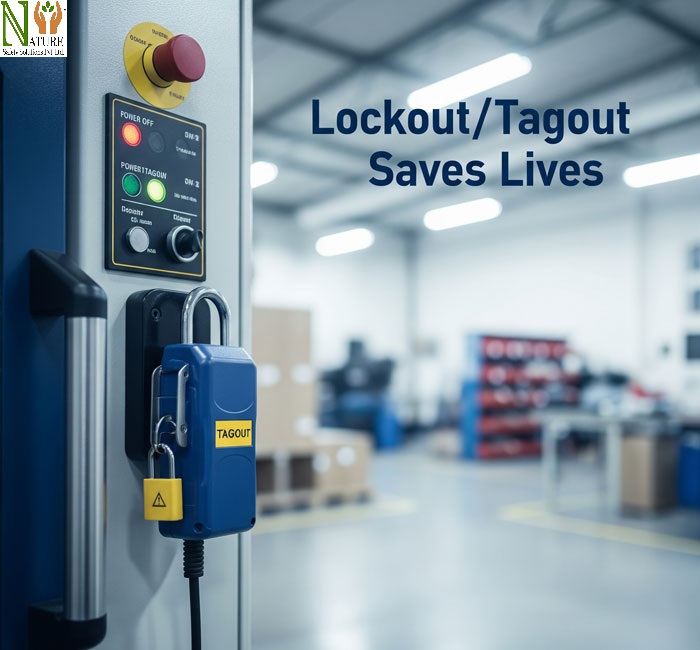In the busy world of industrial work, machines are always running, and processes are closely connected. But this comes with a serious risk—the sudden release of hazardous energy. This energy can appear in many forms: electrical, mechanical, hydraulic, pneumatic, chemical, thermal, or even stored energy like gravity or compressed springs.
If released without warning, this energy can turn a routine job into a disaster. It can cause severe injuries, death, or major damage to property.
That’s where Lockout/Tagout (LOTO) plays a vital role. It isn’t just a simple safety rule. It’s the first and most important line of defense against these types of accidents.
LOTO is a carefully planned safety procedure. It prevents machines from being started or powered up while workers are servicing them. Its main purpose is to make sure that machines are fully shut down and cannot move or release energy during maintenance or repair work.

What is Lockout/Tagout?
LOTO involves two primary components:
Lockout: This involves putting a physical lock on an energy-isolating device like a circuit breaker, valve, or switch. The lock makes sure the device cannot be used, so the machine stays off.
Every authorized worker uses their own lock. Only that worker can remove their lock after finishing their task. This “one worker, one lock” rule is very important. It ensures accountability and keeps everyone safe.
Tagout: Tagout means attaching a visible warning tag to the energy-isolating device. The tag shows that the equipment is under maintenance and must not be turned on.
It gives important details like the reason for the tag, the date, and the worker’s name. A tag is a warning sign but doesn’t physically stop the machine from being turned on. That’s why lockout is usually safer and often required when possible.
Why is LOTO Your First Defense?
The effectiveness of LOTO as a primary defense lies in its proactive nature and comprehensive approach to hazard control:
Eliminates the Hazard at the Source
Lockout/Tagout (LOTO) removes the danger by shutting down and de-energizing the machine. This is different from personal protective equipment (PPE), which only protects the worker from the hazard.
LOTO gets rid of the hazard itself. According to the hierarchy of controls, elimination is the most effective way to control risks—better than substitution, engineering controls, administrative steps, or PPE.
Prevents Unintended Startup
One of the most dangerous accidents happens when a machine starts unexpectedly while someone is working on or near it. This can lead to serious injuries or even death.
Lockout/Tagout (LOTO) stops this from happening. It isolates the energy source and keeps the machine completely shut down. The machine stays off until the job is done and all workers are safely out of the area.
Controls Stored Energy
Some machines still hold dangerous energy even after they are turned off. This stored energy can come from things like compressed air, hydraulic pressure, charged electrical parts, or heavy parts held up by gravity.
Lockout/Tagout (LOTO) makes sure this energy is safely handled. The procedure includes steps to release, block, or secure the energy so it cannot harm anyone.
Promotes Accountability
The rule of “one worker, one lock” builds strong personal responsibility. Each authorized worker uses their own lock and is responsible for it. This ensures the equipment stays safe while they are working. It also stops anyone else from removing the lock without permission.
Standardizes Safety Procedures
A strong Lockout/Tagout (LOTO) program includes clear, step-by-step instructions for each machine. These procedures are specific to the equipment. This standard approach makes sure all workers follow the same safe methods. It helps prevent mistakes and keeps everyone protected.
Reduces Human Error
Lockout/Tagout (LOTO) turns the shutdown process into a clear, step-by-step routine. Each action is planned and recorded. This helps prevent mistakes that could cause accidents. Workers must follow and verify every step, so they don’t rely on guesses or take shortcuts.
The Consequences of Neglecting LOTO
Ignoring or circumventing LOTO procedures can have devastating consequences:
- Fatalities: Workers can be crushed, entangled, electrocuted, or burned by unexpectedly energized machinery.
- Severe Injuries: Amputations, broken bones, severe burns, and internal injuries are common outcomes.
- Property Damage: Uncontrolled energy release can damage machinery, leading to costly repairs and production downtime.
- Legal Repercussions: Companies and individuals can face hefty fines, legal prosecution, and reputational damage for LOTO violations, especially in regions with stringent safety regulations.
- Low Morale: Accidents due to neglected safety procedures erode trust, lower morale, and create a fearful work environment.
Key Components of an Effective LOTO Program
To truly serve as a “first defense,” a LOTO program must be comprehensive and continuously reinforced:
- Written LOTO Procedures: Machine-specific, detailed procedures outlining every step for isolating, locking out, and re-energizing equipment.
- Employee Training: All affected and authorized employees must receive thorough training on LOTO procedures, including recognizing energy sources, the purpose of LOTO, and their specific roles and responsibilities. Retraining should be conducted regularly.
- Energy Control Devices: Availability of appropriate lockout devices (locks, tags, chains, wedges, blocks) and energy-isolating devices.
- Periodic Inspections: Regular reviews of LOTO procedures and employee compliance to ensure effectiveness and identify any deficiencies.
- Communication: Clear and consistent communication among shifts, departments, and contractors regarding LOTO status.
- Authorized vs. Affected Employees: Differentiating between “authorized” employees (who perform LOTO) and “affected” employees (who operate or work near locked-out equipment) is crucial for tailored training and understanding.
Also read:-
